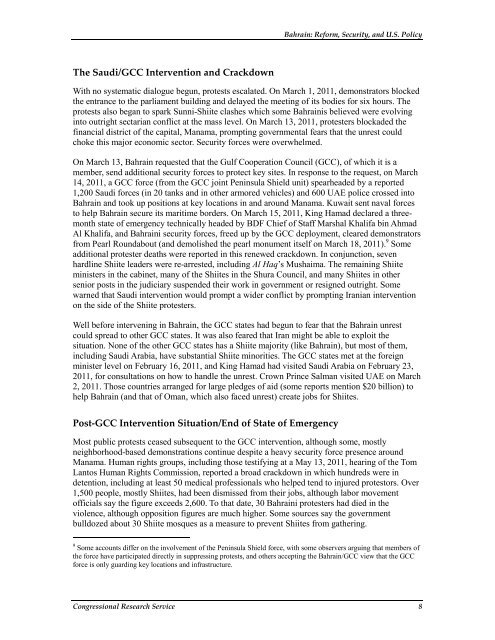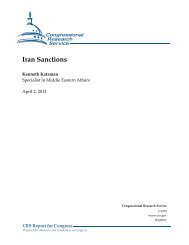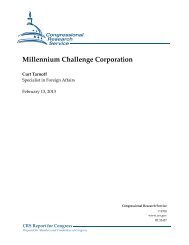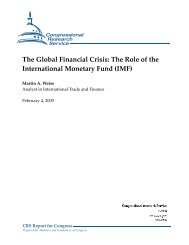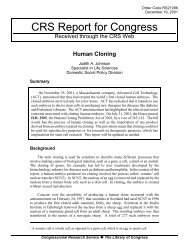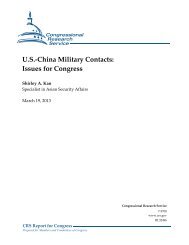Bahrain: Reform, Security, and U.S. Policy - Foreign Press Centers
Bahrain: Reform, Security, and U.S. Policy - Foreign Press Centers
Bahrain: Reform, Security, and U.S. Policy - Foreign Press Centers
You also want an ePaper? Increase the reach of your titles
YUMPU automatically turns print PDFs into web optimized ePapers that Google loves.
The Saudi/GCC Intervention <strong>and</strong> Crackdown<br />
<strong>Bahrain</strong>: <strong>Reform</strong>, <strong>Security</strong>, <strong>and</strong> U.S. <strong>Policy</strong><br />
With no systematic dialogue begun, protests escalated. On March 1, 2011, demonstrators blocked<br />
the entrance to the parliament building <strong>and</strong> delayed the meeting of its bodies for six hours. The<br />
protests also began to spark Sunni-Shiite clashes which some <strong>Bahrain</strong>is believed were evolving<br />
into outright sectarian conflict at the mass level. On March 13, 2011, protesters blockaded the<br />
financial district of the capital, Manama, prompting governmental fears that the unrest could<br />
choke this major economic sector. <strong>Security</strong> forces were overwhelmed.<br />
On March 13, <strong>Bahrain</strong> requested that the Gulf Cooperation Council (GCC), of which it is a<br />
member, send additional security forces to protect key sites. In response to the request, on March<br />
14, 2011, a GCC force (from the GCC joint Peninsula Shield unit) spearheaded by a reported<br />
1,200 Saudi forces (in 20 tanks <strong>and</strong> in other armored vehicles) <strong>and</strong> 600 UAE police crossed into<br />
<strong>Bahrain</strong> <strong>and</strong> took up positions at key locations in <strong>and</strong> around Manama. Kuwait sent naval forces<br />
to help <strong>Bahrain</strong> secure its maritime borders. On March 15, 2011, King Hamad declared a threemonth<br />
state of emergency technically headed by BDF Chief of Staff Marshal Khalifa bin Ahmad<br />
Al Khalifa, <strong>and</strong> <strong>Bahrain</strong>i security forces, freed up by the GCC deployment, cleared demonstrators<br />
from Pearl Roundabout (<strong>and</strong> demolished the pearl monument itself on March 18, 2011). 9 Some<br />
additional protester deaths were reported in this renewed crackdown. In conjunction, seven<br />
hardline Shiite leaders were re-arrested, including Al Haq’s Mushaima. The remaining Shiite<br />
ministers in the cabinet, many of the Shiites in the Shura Council, <strong>and</strong> many Shiites in other<br />
senior posts in the judiciary suspended their work in government or resigned outright. Some<br />
warned that Saudi intervention would prompt a wider conflict by prompting Iranian intervention<br />
on the side of the Shiite protesters.<br />
Well before intervening in <strong>Bahrain</strong>, the GCC states had begun to fear that the <strong>Bahrain</strong> unrest<br />
could spread to other GCC states. It was also feared that Iran might be able to exploit the<br />
situation. None of the other GCC states has a Shiite majority (like <strong>Bahrain</strong>), but most of them,<br />
including Saudi Arabia, have substantial Shiite minorities. The GCC states met at the foreign<br />
minister level on February 16, 2011, <strong>and</strong> King Hamad had visited Saudi Arabia on February 23,<br />
2011, for consultations on how to h<strong>and</strong>le the unrest. Crown Prince Salman visited UAE on March<br />
2, 2011. Those countries arranged for large pledges of aid (some reports mention $20 billion) to<br />
help <strong>Bahrain</strong> (<strong>and</strong> that of Oman, which also faced unrest) create jobs for Shiites.<br />
Post-GCC Intervention Situation/End of State of Emergency<br />
Most public protests ceased subsequent to the GCC intervention, although some, mostly<br />
neighborhood-based demonstrations continue despite a heavy security force presence around<br />
Manama. Human rights groups, including those testifying at a May 13, 2011, hearing of the Tom<br />
Lantos Human Rights Commission, reported a broad crackdown in which hundreds were in<br />
detention, including at least 50 medical professionals who helped tend to injured protestors. Over<br />
1,500 people, mostly Shiites, had been dismissed from their jobs, although labor movement<br />
officials say the figure exceeds 2,600. To that date, 30 <strong>Bahrain</strong>i protesters had died in the<br />
violence, although opposition figures are much higher. Some sources say the government<br />
bulldozed about 30 Shiite mosques as a measure to prevent Shiites from gathering.<br />
9 Some accounts differ on the involvement of the Peninsula Shield force, with some observers arguing that members of<br />
the force have participated directly in suppressing protests, <strong>and</strong> others accepting the <strong>Bahrain</strong>/GCC view that the GCC<br />
force is only guarding key locations <strong>and</strong> infrastructure.<br />
Congressional Research Service 8


